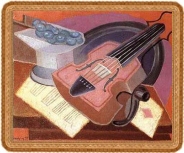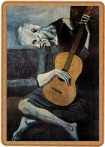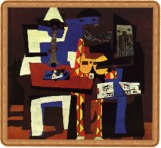|
  
Buy
These Art Print At AllPosters.com
 Cubism
In 1907, Pablo Picasso
Cubism
In 1907, Pablo Picasso and George Braque
and George Braque were looking for a way to show painting subjects from several directions
at the same time. They were influenced by Paul Cezanne
were looking for a way to show painting subjects from several directions
at the same time. They were influenced by Paul Cezanne who suggested looking, in nature, for shapes of cubes, cones and cylinders.
His goal was a painting that was simple, yet one of depth and firmness.
The cubists decided to paint the different appearances
of an object at once, some of which clear and others fade (thus,
a violin can be painted with its different parts showing, both sidewise
with the resonance holes in the front as well, and so on). To
the geometric forms they used, they added newspaper clippings and collages
cutting in their paintings to alter the appearance. To some extent,
here we have use of the painting rules of ancient
Egypt
who suggested looking, in nature, for shapes of cubes, cones and cylinders.
His goal was a painting that was simple, yet one of depth and firmness.
The cubists decided to paint the different appearances
of an object at once, some of which clear and others fade (thus,
a violin can be painted with its different parts showing, both sidewise
with the resonance holes in the front as well, and so on). To
the geometric forms they used, they added newspaper clippings and collages
cutting in their paintings to alter the appearance. To some extent,
here we have use of the painting rules of ancient
Egypt ,
where every object is presented from the angle where its shape was seen
the clearest. Yet the cubists also learned from primitive art and Totem
poles, how to assemble a picture from pieces and give it a sense of completeness.
It was clear to the cubists that the condition to
their success, was that the observer already knows the ordinary look of
the painted object - and therefore concentrated on painted well-known things.
If a person did not know how a violin looked in real life, he would find
it difficult to link the different parts of the cubist painting together
in his or her imagination. Cubism's focus on shape
more than topic characterises the art of the 20th century, and to a great
extent, similar changes occurred in music. The painter and musician Paul
Klee ,
where every object is presented from the angle where its shape was seen
the clearest. Yet the cubists also learned from primitive art and Totem
poles, how to assemble a picture from pieces and give it a sense of completeness.
It was clear to the cubists that the condition to
their success, was that the observer already knows the ordinary look of
the painted object - and therefore concentrated on painted well-known things.
If a person did not know how a violin looked in real life, he would find
it difficult to link the different parts of the cubist painting together
in his or her imagination. Cubism's focus on shape
more than topic characterises the art of the 20th century, and to a great
extent, similar changes occurred in music. The painter and musician Paul
Klee explained the excitement cubism provokes, in the possibilities of playing
with shapes, and not as a new method of representing reality.
explained the excitement cubism provokes, in the possibilities of playing
with shapes, and not as a new method of representing reality.
|


